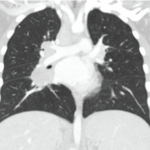Although the ACR Research and Education Foundation offers a number of opportunities to students interested in rheumatology, the Ephraim P. Engleman Endowed Resident Research Preceptorship is a unique opportunity that allows for a much more in-depth learning experience. The purpose of the Engleman Preceptorship is to introduce residents to the specialty of rheumatology by supporting a full-time research experience, with the goal of attracting promising physician–scientists to the field of rheumatology early in their careers.
The ACR/CHEST ILD Guidelines in Practice, a video
In collaboration with the American College of Chest Physicians, the ACR released two new comprehensive guidelines aimed at improving the screening, monitoring, and treatment of patients with interstitial lung disease (ILD) secondary to systemic autoimmune rheumatic diseases (SARDs). Recently, Sindhu R. Johnson, MD, PhD, professor of medicine at the University of Toronto, Canada, director of the Toronto Scleroderma Program and principal investigator for the guideline, and Elana J. Bernstein, MD, MSc, Florence Irving associate professor of medicine in the Division of Rheumatology at Columbia University, New York City, and co-first author, presented a webinar to talk about how the guidelines were developed and present some of the recommendations and their rationale: Watch the recording now!
RheumPAC: Advance Rheumatology on Capital Hill
One way to succeed in our mission of advancing rheumatology is to increase the ACR’s presence on Capitol Hill through grassroots and direct lobbying. However, for the rheumatology subspecialty to be most effective we must use all tools available to us, including RheumPAC, the ACR’s nonpartisan political action committee. RheumPAC demonstrates to members of Congress that the rheumatology subspecialty is committed to political action, educating policy makers, and improving healthcare for our patients.
Gabriel to Chair Healthcare Reform Panel
Former ACR president assigned key role in transforming nation’s healthcare system
Opioids More Dangerous than other Analgesics for Elderly
Safety events vary among different opioids
New Guidance for Rheumatologists who Treat JIA
Evidence and consensus-based recommendations reflects current knowledge about initiation of therapy
Rheum with a View
Panush’s perspectives on selections from the literature
He Taught Us to Always Go Deeper
Eng Tan, MD, promotes translation from bench to bedside
Advocate from Your Office the Week of March 14
The ACR is urging the 112th Congress to address many issues important to rheumatology including appropriate reimbursement for specialty care, the repeated battle to avert Medicare payment cuts, funding for the pediatric subspecialty loan repayment program, continued fair reimbursement for dual-energy X-ray absorptiometry scans, and the need for increased research funding.
A Huge Thank You to 251 People
RheumPAC supporters are helping to advance rheumatology
Arthritis Foundation Honors Excellence in Rheumatology
AF award recipients include renowned investigator and professor emeritus
- « Previous Page
- 1
- …
- 271
- 272
- 273
- 274
- 275
- …
- 309
- Next Page »
